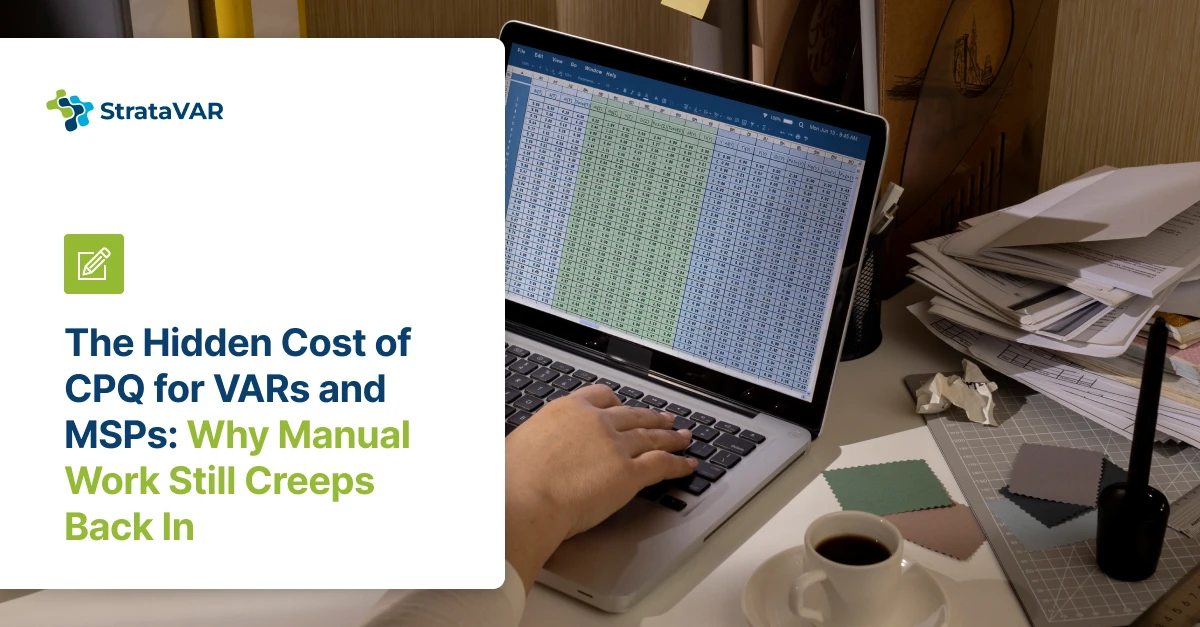The Hidden Cost of CPQ for VARs and MSPs: Why Manual Work Still Creeps Back In

This is a div block with a Webflow interaction that will be triggered when the heading is in the view.
This is a div block with a Webflow interaction that will be triggered when the heading is in the view.
Configure Price Quote (CPQ) platforms promise to automate one of the most painful and critical parts of the sales process. For Value-Added Resellers (VARs) and Managed Service Providers (MSPs), the benefits are even greater. They get streamlined quoting across complex vendor catalogs and supplier quotes, experience fewer errors, and close deals faster.
Yet, in practice, many VARs and technology resellers still find themselves buried in spreadsheets. In fact, they get stuck in duplicate quotes or manually key in data. This disconnect stems from a fundamental problem. Most CPQ platforms were not designed with the ICT channel in mind.
They were built for generic direct sales, not for businesses managing tens of thousands of SKUs, complex bundles, and distributor dependencies. Leading CPQ vendors offer powerful functionality, but they share a critical weakness. In real-world VAR and MSP operations, these systems often have gaps that force sales teams to go back to manual work. In this article, we will discuss the hidden costs of CPQ for MSPs and VARs in detail.
Where CPQ Falls Short for VARs and MSPs
Here are the most common gaps we see in CPQ deployments for the channel. Each represents a point where the system breaks down, and people fill the gap with manual effort. It is usually at the cost of efficiency, accuracy, and customer satisfaction.
Even the most powerful CPQ tool can struggle with real-world VAR and MSP operations. This forces teams back into spreadsheets instead of true channel quoting automation.
1. Data Gaps
API and catalog synchronization
Resellers rely on accurate, real-time data from vendors (such as Cisco, HP, Dell). On the other hand, distributors (like Ingram Micro and TD SYNNEX). While CPQ vendors advertise integrations, in reality, these feeds are shallow or fragile. A change in a distributor’s file format can cause mismatches.
Without a purpose-built CPQ, VARs' sales teams often have to re-enter pricing and availability line by line. It is also worth noting that for many VAR transactions, simple catalog integration is not sufficient. Configurations are complex and often require the creation of a detailed Bill of Materials (BoM). While these BoMs may include items from an OEM’s or distributor’s catalog, the pricing is rarely aligned with standard list prices.
Instead, pricing is tailored to the specific end customer or deal context. Standard CPQ systems struggle with this scenario, as they generally assume a consistent cost price for each SKU. In practice, the same SKU may have different prices depending on the transaction. Eventually, it leads to significant manual effort and workarounds to ensure accuracy.
Supplier Quote parsing
In cases where APIs are not available, resellers import supplier files in Excel, PDF, or XML. Without intelligent parsing of supplier quotes, much of this data entry still happens manually. Teams copy values into the channel CPQ software, increasing the risk of errors and slowing down the quoting cycle.
ERP downstream integration
Even when quotes are generated correctly, weak integration with ERP systems often forces manual re-entry of purchase orders and sales orders. A quote-to-cash for VARs ensures seamless synchronization between quoting, ordering, and billing, eliminating errors and streamlining the process.
Some of the typical issues include SKU validation requirements, splitting quotes across multiple vendors, line-item limits that prevent large quotes from being pushed in a single transaction, and difficulty handling multiple ship-to locations.
While customers expect one consolidated quote, the ERP usually requires that it be broken down and restructured before synchronization. Most generic CPQ systems struggle to manage this level of complexity. This leaves procurement and finance teams to manually fill the gaps.
2. Volume and Scalability Gaps
High-volume quotes
VARs often generate quotes with thousands of line items, particularly for hardware-intensive maintenance contract projects. The best CPQ for VARs can handle such high-volume quoting efficiently, preventing timeouts or slowdowns while maintaining accuracy.
Many generic CPQs cannot handle this scale efficiently. A CPQ for hardware resellers or the best CPQ for MSPs can manage high-volume quotes without lag. It helps sales teams avoid breaking quotes into smaller batches or relying on spreadsheets.
3. Complexity Gaps
Multi-dimensional calculations
In the channel, pricing is rarely linear. VARs need to adjust cost, customer price, discount, and margin dynamically, with each change recalculating the others. Standard CPQs struggle with this, leaving reps to make manual adjustments and reconcile calculations outside the system. A CPQ for ICT resellers or a CPQ for IT resellers can handle these complex pricing scenarios efficiently.
Multi-currency handling
For global resellers, quotes often involve multiple currencies and dated exchange rates. The result is that finance teams export quotes and manually adjust them to reflect accurate currency conversions. This is a challenge that can be streamlined with dynamic multi-currency quoting solutions.
Cost and Price vs. Catalogue Selling
Unlike direct-sales models, where pricing is tied to a static catalogue, VAR transactions are driven by a unique cost and a unique selling price for every deal. The same SKU may have different costs depending on the distributor quote, vendor program, or customer context. Generic CPQs assume a fixed cost per SKU, which makes it impossible to accurately reflect this reality.
4. Commercial and Financial Gaps
Vendor rebate programs
Rebates like Cisco VIP / CSPP can significantly impact margins, but many CPQs treat them as afterthoughts. Without real-time rebate visibility inside the quote, sales reps cannot present the most competitive pricing, and finance is left reconciling rebates manually after the fact.
Renewal and end-of-life (EoX) management
For MSPs managing hundreds of maintenance and licensing renewals, missing an end-of-life notification can jeopardize client relationships. Few CPQs offer proactive renewal management with EoX tracking, so teams maintain parallel renewal spreadsheets and reminders to prevent gaps.
Blended CapEx and OpEx quoting
Channel deals often mix hardware purchases, one-time services, and recurring managed services. Many CPQs cannot handle this mix natively. Hence, finance teams have to split invoices manually and adjust tax treatments line by line.
5. Workflow and Usability Gaps
Exporting to Excel and custom formats
Clients often demand quotes in their preferred template or format. Standard CPQs export to PDF or a fixed layout, so resellers export data and reformat it in Excel or Word manually. This wastes hours per deal cycle.
Complex approvals and special-bid pricing
Special-bid requests with multi-layer approvals often stall in CPQ workflows. To keep deals moving, reps duplicate quotes with adjusted pricing outside the system and circulate them manually. The outcome is version confusion and poor audit trails.
Weak vendor support
When issues arise, CPQ vendor support is often slow to respond. More importantly, their customer success teams are not VAR specialists, which makes it difficult for them to understand the nuances of distributor feeds, rebates, and renewal cycles. Without experts who speak the same language, resellers are left to solve problems on their own or fall back on manual fixes.
6. Stability and Platform Gaps
Release and update instability
Some CPQ vendors push updates or changes with little warning. Custom scripts and integrations break, leaving quoting systems inoperable until fixes are applied. When this happens at month-end or quarter-close, sales teams have no choice but to revert to spreadsheets to keep deals moving.
Migration limbo
We have seen cases where CPQ vendors force customers off their legacy product and into a new one. During these transitions, many teams run both systems in parallel while also maintaining spreadsheets to fill functional gaps. This migration limbo doubles the workload instead of reducing it.
Single-code platform rigidity
Some CPQ platforms are single-code solutions. Any change or update that impacts the entire customer base limits flexibility and forces resellers to build manual workarounds for their unique requirements.
Performance overhead
Large catalogs and complex configurations strain CPQ platforms not optimized for scale. The lag or failure to render quotes drives sales teams back into offline tools where they feel they have more control.
7. Customization Gaps
Generic CPQs often force resellers into rigid models. For VARs and MSPs, this creates real problems: quoting must reflect unique vendor programs, customer-specific pricing, and complex internal workflows. A purpose-built solution needs to combine both configuration and customization, so the system adapts to the business, not the other way around.
For VARs, quoting is not about static catalogue prices; each deal has a unique cost and selling price. Without the flexibility to reflect this reality, sales teams often resort to using spreadsheets. Customization keeps quoting tools aligned with real-world operations, eliminating manual effort and protecting margins.
While Configuration adapts what already exists, user roles, fields, or integration settings, Customization extends the platform further, adding workflows, modules, or automations that are unique to each VAR. Together, they ensure the tool evolves in tandem with the business, rather than holding it back.
What VARs Should Expect
- Flexible architecture: Each customer operates its own SaaS instance, ensuring security, privacy, and freedom to adapt.
- Tailored workflows: Automated flows, bespoke fields, reports, and dashboards that fit VAR-specific processes.
- Ownership: Customizations remain under your control, protecting differentiation.
- Continuity: Custom features stay aligned with updates thanks to structured CICD release cycles.
- Future-proofing: Capacity to support new vendor programs and evolving business models.
The Cost of Manual Work
Every gap comes back to the same outcome: manual effort creeping back into supposedly automated processes. This has several consequences:
- Lost time: sales teams spend hours reconciling data instead of engaging customers.
- Errors and leakage: manual entry increases mistakes, from pricing inaccuracies to missed rebates. This can further erode already fragile margin levels.
- Revenue impact: delayed renewals, missed deadlines, and broken approvals slow down sales cycles and hurt customer trust.
- Employee frustration: sales and operations teams lose faith in the system, further reinforcing the reliance on offline tools.
What VARs and MSPs Need
A CPQ solution purpose-built for the channel should eliminate these gaps, not force teams to work around them. That means:
- Real-time distributor and vendor integrations that actually work.
- Native BoM parsing and large-scale quoting capacity.
- Flexible pricing calculations and multi-currency support.
- Embedded rebate programs and proactive renewal management.
- Stable release cycles and strong support responsiveness.
- Seamless integration across quoting, ordering, and ERP systems.
- Built by VAR experts, supported by VAR experts.
- Flexibility to customize
Conclusion
The reality is simple: when CPQ platforms are not designed for the channel, VARs and MSPs end up right back in spreadsheets. Each workaround incurs additional costs, risks, and delays. The right solution must reflect the operational realities of ICT resellers: distributor feeds, complex bundles, renewals, rebates, and global scale, while delivering the automation that CPQ originally promised. Only then can resellers focus on selling value instead of fixing quotes.
FAQs: CPQ for managed service
How does a purpose-built CPQ for VARs handle complex distributor rebates and pricing tiers?
A purpose-built CPQ for VARs automatically applies distributor rebates, tiered pricing, and vendor-specific programs. This makes it a reliable channel quoting solution that reduces manual work.
Can a channel CPQ software manage multi-currency quoting for global MSP deals?
Yes, a channel CPQ software calculates prices in multiple currencies using real-time exchange rates. Hence, it is an accurate quoting platform for resellers handling international deals.
What features should I look for in a quoting platform for resellers to manage large Bill of Materials (BoM)?
Choose a quoting platform for resellers that offers automated BoM parsing, bulk SKU updates, and validation.



